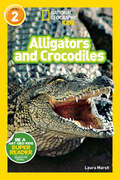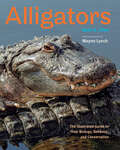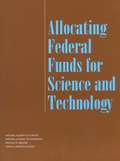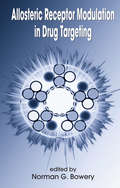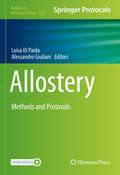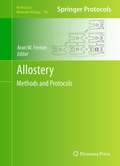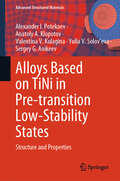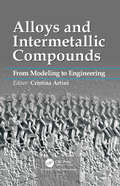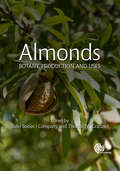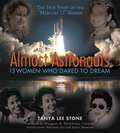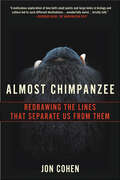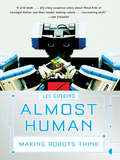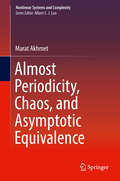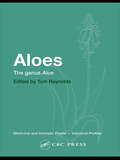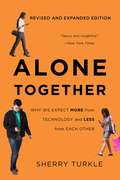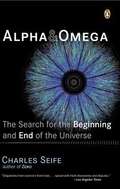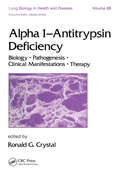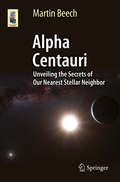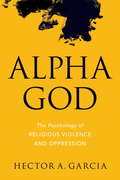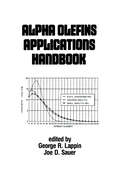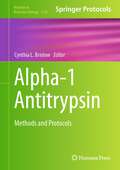- Table View
- List View
Alligators and Crocodiles (Readers)
by Laura MarshA pair of eyes lurks just above the water's surface. Is it a crocodile or an alligator? Packed with beautiful and engaging photos, kids will learn all about these two reptiles—and find out what makes them different. This level 2 reader provides both accessible and wide-ranging text to encourage the scientists and explorers of tomorrow!
Alligators and Other Crocodilians (World Book's Animals of the World)
by Bari D. FairweatherThis is a fascinating book. Do you know which crocodilian is the smallest? Do you know what Spanish explorers called crocodiles?
Alligators: The Illustrated Guide to Their Biology, Behavior, and Conservation
by Kent A. VlietThe ultimate guide to understanding the biology and behavior of the amazing and underappreciated American alligator.Few scenes put the senses on edge more than a submerged alligator, only eyes and snout showing, when peering across a southern lake on a misty morning. An iconic American predator, these reptiles grow to thirteen feet or more and can live as long as humans. Alligators are complex creatures, capable of terrific attacks and yet tending to their young in the same gentle way a mother duck looks after her brood. Once extremely numerous, alligators came close to extinction in the twentieth century, but thanks to conservation efforts have since made a comeback, reclaiming their rightful place as the monarchs of the southern wetlands.In this fascinating account, richly illustrated with more than 150 photographs from award-winning wildlife photographer Wayne Lynch, expert zoologist Kent A. Vliet introduces readers to the biology, ecology, and natural history of the American alligator. Sharing nuanced depictions of their hidden lives that will forever change the way you think of these giant reptiles, the book• combines captivating storytelling with the most current scientific facts• chronicles the life cycle of the alligator• explains why the alligator's precise anatomy and physiology make it so successful• covers a wide range of topics, from courtship and reproduction to communication, basking, nest-building, and hunting• reveals the alligator's sophisticated social life in detail• evaluates the alligator's environmental role as a keystone species• examines the complicated relationship between alligators and people
Allocating Federal Funds for Science and Technology
by Development Committee on Criteria for Federal Support of ResearchThe United States faces a new challenge--maintaining the vitality of its system for supporting science and technology despite fiscal stringency during the next several years. To address this change, the Senate Appropriations Committee requested a report from the National Academies of Sciences and Engineering and the Institute of Medicine to address "the criteria that should be used in judging the appropriate allocation of funds to research and development activities; to examine the appropriate balance among different types of institutions that conduct such research; and to look at the means of assuring continued objectivity in the allocation process." In this eagerly-awaited book, a committee of experts selected by the National Academies and the Institute responds with 13 recommendations that propose a new budgeting process and formulates a series of questions to address during that process. The committee also makes corollary recommendations about merit review, government oversight, linking research and development to government missions, the synergy between research and education, and other topics. The recommendations are aimed at rooting out obsolete and inadequate activities to free resources from good programs for even better ones, in the belief that "science and technology will be at least as important in the future as they have been in the past in dealing with problems that confront the nation." The authoring committee of this book was chaired by Frank Press, former President of the National Academy of Sciences (1981-1993) and Presidential Science and Technology Advisor (1977-1981).
Allosteric Enzymes
by Guy HerveThis book compiles detailed information concerning a dozen of the best known allosteric enzymes, and so allows the comparison of their regulatory mechanisms and the confrontation of these mechanisms with the theoretical models. Stimulating and unexpected ideas emerge from these comparisons and emphasize the importance of developing various methods of investigation such as crystallography, X-ray solution scattering, and the study of fast movements in proteins and site-directed mutagenesis. This book is addressed to students and researchers interested in structure-function relationship in proteins, enzymology and metabolic regulation. It is also a basis for teaching.
Allosteric Receptor Modulation in Drug Targeting
by Norman G. BoweryOffering a wide array of illustrations and tables in every chapter, this book extensively covers the principles of allosterism in reference to drug action and progresses to a detailed examination of individual ionotropic and G-protein coupled receptor systems-helping those new to the subject understand the importance of allosterism and providing th
Allostery: Methods and Protocols (Methods in Molecular Biology #2253)
by Alessandro Giuliani Luisa Di PaolaThis volume explores the basic issues of “allostery” and “network” that are fundamental to studying this field. Chapters in this book look at how the basic “machine-like” proteins, that are similar to “human machines,” need to be organized, architecturally, to relate to different organizational layers. Chapters cover topics such as methodological/computational factors focused on links between allostery and network formalism; the presence of oscillating modes transversing the structure and underlying network wiring of the allosteric process; the “action at distance” by transduction of signals across an organized network structure; and the P53 protein located at the cross-road of cell cycle regulation, genome integrity, and cancer development. Written in the highly successful Methods in Molecular Biology series format, chapters include introductions to their respective topics, lists of the necessary materials and reagents, step-by-step, readily reproducible laboratory protocols, and tips on troubleshooting and avoiding known pitfalls.Thorough and practical, Allostery: Methods and Protocols is a valuable resource for any scientists and researcher interested in learning more about this developing field.
Allostery: Methods and Protocols (Methods in Molecular Biology #796)
by Aron W. FentonDespite considerable variability within the scientific community, allosteric regulation can best be defined functionally as how a macromolecule binds one ligand differently when a second ligand is or is not pre-bound to the macromolecule, which constitutes a vital aspect of protein structure/function. In Allostery: Methods and Protocols, expert researchers in the field provide key techniques to investigate this biological phenomenon. Focusing on heterotropic systems with some coverage of homotropic systems, this volume covers the monitoring of allosteric function, allosteric conformational changes, and allosteric changes in protein dynamics/sub-population distribution, as well as topics such as macromolecular and ligand engineering of allosteric functions and computational aids in the study of allostery. Written in the highly successful Methods in Molecular BiologyTM series format, the chapters include the kind of detailed description and implementation advice that is crucial for getting optimal results in the laboratory. Thorough and intuitive, Allostery: Methods and Protocols aids scientists in continuing to study ligand-induced, through-protein effects on protein function (ligand binding/catalysis), a phenomenon that is well recognized through the history of the life sciences and very poorly understood at the molecular level.
Alloys Based on TiNi in Pre-transition Low-Stability States: Structure and Properties (Advanced Structured Materials #216)
by Alexander I. Potekaev Anatoly A. Klopotov Valentina V. Kulagina Yulia V. Solov'eva Sergey G. AnikeevThis book presents the results of research on the regularities during thermocyclic impact on changes in structural-phase states of functional alloys with low-stability or instability in the area of structural-phase transformations. Without clarification of the physical regularities of the influence of thermomechanical impact on the properties of alloys, it is impossible to develop technological processes of processing functional materials; therefore, the book widely uses the results of many years of research by the authors of the book. It is known that critical temperatures and stresses for martensitic transformation, for example, B 2↔︎ B 19′, in NiTi are very sensitive to cycling. The study of structural-phase states, corresponding to changes in physical-mechanical properties of intermetallics in the area of transformations, is a necessary aspect of understanding the nature of the influence of thermomechanical cycling on the properties of functional alloys. This book is dedicated to the fundamental physical aspects of stability, the influence of structural defects on properties and structural-phase transformations of FCC alloys. This book is useful for a wide range of specialists—scientific researchers and engineers, working in the field of materials science and physics of condensed systems, as well as teachers, postgraduates and students, specializing in the field of materials science.
Alloys and Intermetallic Compounds: From Modeling to Engineering
by Cristina ArtiniThis book focuses on the role of modeling in the design of alloys and intermetallic compounds. It includes an introduction to the most important and most used modeling techniques, such as CALPHAD and ab-initio methods, as well as a section devoted to the latest developments in applications of alloys. The book emphasizes the correlation between modeling and technological developments while discussing topics such as wettability of Ultra High Temperature Ceramics by metals, active brazing of diamonds to metals in cutting tools, surface issues in medicine, novel Fe-based superconductors, metallic glasses, high entropy alloys, and thermoelectric materials.
Almonds: Botany, Production and Uses (Botany, Production and Uses)
by Patrick Brown Gregory Reighard Mariano Cambra James Adaskaveg Robert Curtis Vicente Pallás José M Alonso José M Ansón Octavio Arquero Roger A Baldwin Ignasi Batlle Mireia Bordàs Miguel A. Cambra Joseph H. Connell Federico Dicenta David A. Doll Henri Duval Iban Eduardo Daniel Esmenjaud José L Carbó Maria T Espiau Antonio J. Felipe Angel Fernández i Martí Carolina Font i Forcada Helga Förster Luis Iannamico Santiago Izquierdo Sat Darshan Khalsa Ossama Kodad Maria M. López Carmen Martínez Pedro Martínez-Gómez Saiful Muhammad Eva Núñez Seoane Antonio Olmos Ana Palacio-Bielsa Katherine Pope Maria J Rubio-Cabetas Ned T. Ryan Sebastián Sáa Silva Raquel Sánchez-Pérez Francisco J. Vargas Steve Weinbaum Michelle Wirthensohn Shu-Biao Wu Frank G Zalom Alexis VerdúThis book provides a comprehensive overview of almond growing from a scientific and horticultural perspective, covering botany, production, processing and industrial uses. Almonds are an important crop; they are highly regarded for their flavour, nutritional properties and culinary uses, and almond oil is used widely in food, cosmetic and pharmaceutical production. They are easy to transport and have long storability, facilitating global dissemination. Demand is constantly increasing and global production has more than doubled in the last 20 years. The popularity of almonds and the increase in demand has required new plantings and a response to ongoing changes in cultural and climatic conditions. Almonds: Botany, Production and Uses meets the need for up-to-date information on this crop and covers: · botany and taxonomy · cultivation, genetics and breeding · propagation, orchard management and harvesting · pests and diseases · nutrition, marketing and utilization Authored by an international team of experts and presented in full colour throughout, this book is an essential resource for academic researchers and extension workers, as well as growers, orchard managers and industry personnel.
Almost Astronauts: 13 Women Who Dared to Dream
by Tanya Lee StoneNearly twenty years before the first women were allowed into NASA's astronaut program, a group of thirteen women proved not only that they were as tough as any man but also that they were brave enough to challenge the government. Almost Astronauts tells the story of the "Mercury 13" women, who were blocked by prejudice, jealousy, and a note scrawled by one of the most powerful men in Washington. In the end, the inspiring example of these space-age pioneers empowered young people to take their rightful place in the sky and beyond, piloting jets and commanding space capsules.<P><P> Winner of the Sibert Medal
Almost Chimpanzee: Redrawing the Lines That Separate Us from Them
by Jon CohenThe captivating story of how a band of scientists has redrawn the genetic and behavioral lines that separate humans from our nearest cousinsIn the fall of 2005, a band of researchers cracked the code of the chimpanzee genome and provided a startling new window into the differences between humans and our closest primate cousins. For the past several years, acclaimed Science reporter Jon Cohen has been following the DNA hunt, as well as eye-opening new studies in ape communication, human evolution, disease, diet, and more. In Almost Chimpanzee, Cohen invites us on a captivating scientific journey, taking us behind the scenes in cutting-edge genetics labs, rain forests in Uganda, sanctuaries in Iowa, experimental enclaves in Japan, even the Detroit Zoo. Along the way, he ferries fresh chimp sperm for a time-sensitive analysis, gets greeted by pant-hoots and chimp feces, and investigates an audacious attempt to breed a humanzee. Cohen offers a fresh and often frankly humorous insider's tour of the latest research, which promises to lead to everything from insights about the unique ways our bodies work to shedding light on stubborn human-only problems, ranging from infertility and asthma to speech disorders. And in the end, Cohen explains why it's time to move on from Jane Goodall's plea that we focus on how the two species are alike and turns to examining why our differences matter in vital ways—for understanding humans and for increasing the chances to save the endangered chimpanzee.
Almost Human: Making Robots Think
by Lee GutkindA remarkable, intense portrait of the robotic subculture and the challenging quest for robot autonomy. The high bay at the Robotics Institute at Carnegie Mellon University is alive and hyper night and day with the likes of Hyperion, which traversed the Antarctic, and Zoe, the world's first robot scientist, now back home. Robot Segways learn to play soccer, while other robots go on treasure hunts or are destined for hospitals and museums. Dozens of cavorting mechanical creatures, along with tangles of wire, tools, and computer innards are scattered haphazardly. All of these zipping and zooming gizmos are controlled by disheveled young men sitting on the floor, folding chairs, or tool cases, or huddled over laptops squinting into displays with manic intensity. Award-winning author Lee Gutkind immersed himself in this frenzied subculture, following these young roboticists and their bold conceptual machines from Pittsburgh to NASA and to the most barren and arid desert on earth. He makes intelligible their discoveries and stumbling points in this lively behind-the-scenes work.
Almost Periodicity, Chaos, and Asymptotic Equivalence (Nonlinear Systems and Complexity #27)
by Marat AkhmetThe central subject of this book is Almost Periodic Oscillations, the most common oscillations in applications and the most intricate for mathematical analysis. Prof. Akhmet's lucid and rigorous examination proves these oscillations are a "regular" component of chaotic attractors. The book focuses on almost periodic functions, first of all, as Stable (asymptotically) solutions of differential equations of different types, presumably discontinuous; and, secondly, as non-isolated oscillations in chaotic sets. Finally, the author proves the existence of Almost Periodic Oscillations (asymptotic and bi-asymptotic) by asymptotic equivalence between systems. The book brings readers' attention to contemporary methods for considering oscillations as well as to methods with strong potential for study of chaos in the future. Providing three powerful instruments for mathematical research of oscillations where dynamics are observable and applied, the book is ideal for engineers as well as specialists in electronics, computer sciences, robotics, neural networks, artificial networks, and biology.Distinctively combines results and methods of the theory of differential equations with thorough investigation of chaotic dynamics with almost periodic ingredients;Provides all necessary mathematical basics in their most developed form, negating the need for any additional sources for readers to start work in the area;Presents a unique method of investigation of discontinuous almost periodic solutions in its unified form, employed to differential equations with different types of discontinuity;Develops the equivalence method to its ultimate effective state such that most important theoretical problems and practical applications can be analyzed by the method.
Aloes: The genus Aloe (Medicinal And Aromatic Plants S. - Industrial Profiles Ser. #Vol. 35)
by Tom ReynoldsAloes are a large genus of plants, about 450 species, from sub-Saharan Africa, Madagascar, and parts of Arabia. Many species are widespread in warm or tropical semi-arid regions, yet the distribution of others is limited to a few living in desert or wet mountainous regions. While some species have been adopted as medicinal plants since ancient time
Alone Together: Why We Expect More from Technology and Less from Each Other
by Sherry TurkleConsider Facebook—it’s human contact, only easier to engage with and easier to avoid. Developing technology promises closeness. Sometimes it delivers, but much of our modern life leaves us less connected with people and more connected to simulations of them.In Alone Together, MIT technology and society professor Sherry Turkle explores the power of our new tools and toys to dramatically alter our social lives. It’s a nuanced exploration of what we are looking for—and sacrificing—in a world of electronic companions and social networking tools, and an argument that, despite the hand-waving of today’s self-described prophets of the future, it will be the next generation who will chart the path between isolation and connectivity.
Along Came Galileo
by Jeanne BendickThis look into the life of a courageous man of faith and science has resulted in a wonderful work sure to delight many readers. It was Galileo's questioning mind and insatiable curiousity which drove him to monumental breakthroughs in astronomy, physics, mechanics and the natural world. His many discoveries and inventions challenged and eventually changed 'the acceptabled way of thinking' in these fields of thought. Sadly, Galileo was far ahead of his times and he suffered much injustice for daring to speak those things he knew to be true.
Alpha & Omega
by Charles SeifeThe science of cosmology is on the brink of a evolution. Astronomers and physicists are beginning to answer the ultimate questions that have plagued humanity since prehistory: how was the universe born and how will it end?In just a few years' time, the scientists will ahieve their goal. Already they have glimpsed if the universe; now they are peering into its grave and staring at the face of God. When results from experiments currently being conducted all over the world finally come together, the findings will constitute one of the greatest moments in science - as great as the deciphering of the human genome. ALPHA AND OMEGA tells the story of this 'cosmological revolution and of the scientists who are bringing it about. From mythological origins of the universe to a look at the theories of Aristotle, Galileo, Copernicus, Kepler and Newton, Seife takes us on a gallop across time - and introduces us to the newest figures on the trail: galaxy-hunters and microwave- eavesdroppers, gravity theorists and atom- smashers. He discusses dark matter, dark energy and the particle zoo, and reveals bitter rivalries between brilliant minds pushed to the fringes of science. As we come nearer to an understanding of how the universe began, so we can see where it will all end. Alpha and Omega makes cutting-edge science crystal clear, and provides fascinating, lucid explanations of some of the most stunning scientific ideas of our time.
Alpha 1 - Antitrypsin Deficiency: Biology-Pathogenesis-Clinical Manifestations-Therapy (Lung Biology in Health and Disease)
by Ronald G. CrystalProviding a broad overview of basic and clinical aspects of alpha 1-antitrypsin (a 1AT) deficiency, this up-to-date reference discusses the complex pathobiological processes underlying the pathogenesis of a1AT deficiency, describes the a1AT gene and its promoter, and details specific therapies to prevent the major clinical manifestations of the dis
Alpha Centauri: Unveiling the Secrets of Our Nearest Stellar Neighbor (Astronomers' Universe)
by Martin BeechAs our closest stellar companion and composed of two Sun-like stars and a third small dwarf star, Alpha Centauri is an ideal testing ground of astrophysical models and has played a central role in the history and development of modern astronomy--from the first guesses at stellar distances to understanding how our own star, the Sun, might have evolved. It is also the host of the nearest known exoplanet, an ultra-hot, Earth-like planet recently discovered. Just 4. 4 light years away Alpha Centauri is also the most obvious target for humanity's first directed interstellar space probe. Such a mission could reveal the small-scale structure of a new planetary system and also represent the first step in what must surely be humanity's greatest future adventure--exploration of the Milky Way Galaxy itself. For all of its closeness, α Centauri continues to tantalize astronomers with many unresolved mysteries, such as how did it form, how many planets does it contain and where are they, and how might we view its extensive panorama directly? In this book we move from the study of individual stars to the study of our Solar System and our nearby galactic neighborhood. On the way we will review the rapidly developing fields of exoplanet formation and detection.
Alpha God
by Hector A. GarciaThis book uses evolutionary psychology as a lens to explain religious violence and oppression. The author, a clinical psychologist, examines religious scriptures, rituals, and canon law, highlighting the many ways in which our evolutionary legacy has shaped the development of religion and continues to profoundly influence its expression. The book focuses on the image of God as the dominant male in Judaism, Christianity, and Islam. This traditional God concept is seen as a reflection of the "dominant ape" paradigm so evident in the hierarchical social structures of primates, with whom we have a strong genetic connection.The author describes the main features of male-dominated primate social hierarchies-- specifically, the role of the alpha male as the protector of the group; his sexual dominance and use of violence and oppression to attain food, females, and territory; in-group altruism vs. out-group hostility (us vs. them); and displays of dominance and submission to establish roles within the social hierarchy. The parallels between these features of primate society and human religious rituals and concepts make it clear that religion, especially its oppressive and violent tendencies, is rooted in the deep evolutionary past.This incisive analysis goes a long way toward explaining the historic and ongoing violence committed in the name of religion.From the Trade Paperback edition.
Alpha Olefins Applications Handbook
by George R. Lappin Joe D. SauerThis book discusses the applications of higher linear alpha olefins containing 4 to 30 carbon atoms, describes current commercial uses of alpha olefins, and indicates potential new uses. It also documents methods of production and provides physical property and general property data on the olefins.
Alpha-1 Antitrypsin: Methods and Protocols (Methods in Molecular Biology #2750)
by Cynthia L. BristowThis volume provides a collection of protocols that will allow researchers to further explore the multiple, fascinating activities of Alpha-1 Antitrypsin (AAT) isoforms in innate immunity, and gene therapy. Written in the highly successful Methods in Molecular Biology series format, chapters include introductions to their respective topics, lists of the necessary materials and reagents, step-by-step, readily reproducible laboratory protocols, and tips on troubleshooting and avoiding known pitfalls. Authoritative and cutting-edge, Alpha-1 Antitrypsin: Methods and Protocols aims to ensure successful results in the further study of this vital field.
Alpine Plant Life: Functional Plant Ecology of High Mountain Ecosystems
by Christian KörnerThis book is a completely revised, substantially extended treatment of the physical and biological factors that drive life in high mountains. The book covers the characteristics of alpine plant life, alpine climate and soils, life under snow, stress tolerance, treeline ecology, plant water, carbon, and nutrient relations, plant growth and productivity, developmental processes, and two largely novel chapters on alpine plant reproduction and global change biology. The book explains why the topography driven exposure of plants to dramatic micro-climatic gradients over very short distances causes alpine biodiversity to be particularly robust against climatic change. Geographically, this book draws on examples from all parts of the world, including the tropics. This book is complemented with novel evidence and insight that emerged over the last 17 years of alpine plant research. The number of figures – mostly in color – nearly doubled, with many photographs providing a vivid impression of alpine plant life worldwide.Christian Körner was born in 1949 in Austria, received his academic education at the University of Innsbruck, and was full professor of Botany at the University of Basel from 1989 to 2014. As emeritus Professor he is continuing alpine plant research in the Swiss Alps.
